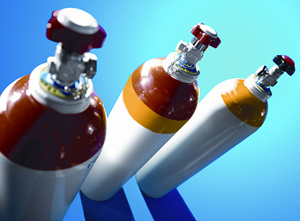Mar 5 2014
Scientists at the National Physical Laboratory (NPL) have produced a synthetic air reference standard which can be used to accurately measure levels of carbon dioxide and methane in the atmosphere. This will greatly help scientists contribute to our understanding of climate change.

A paper published in Analytical Chemistry describes how researchers at NPL have created a synthetic gas standard for the first time, which is comparable to the World Meteorological Organisation (WMO) scale and can be quickly produced in a laboratory and distributed, meeting growing demand.
The bulk of demand for gas standards comes from atmospheric monitoring stations around the world. The data collected from these is important to our understanding of climate change.
To reliably compare the concentration of carbon dioxide and methane in air at different locations, and over time, a primary standard to which all measurements relate is required. We must be able to relate the measurements to a trusted base unit, so we can reliably compare measurement between London and Beijing, or between 1990 and 2014.
The current primary standards for carbon dioxide and methane are a suite of cylinders of compressed air captured from Niwot Ridge in Colorado and held at the National Oceanic and Atmospheric Administration (NOAA).
They are used to create secondary standards, which are used to calibrate the instruments that measure greenhouse gasses around the world.
A new improved measurement technique - cavity ring-down spectroscopy (CRDS) - has resulted in a dramatic increase in the number of atmospheric measurements taken. As the requirement for data that is comparable to the WMO scale increases, there is a corrsponding increase in the demand for comparable reference standards.
Supplying the demand for reference standards comparable to the WMO scale is becoming an issue. An infrastructure to disseminate reference standards prepared gravimetrically, i.e. by weighing the gas in the cylinder - that are traceable to the International System of Units (SI) offers a means of broadening availability. These could overcome the cost and complexity of sampling air under global background conditions which can only be carried out at remote locations.
NPL has developed a solution, producing a synthetic standard which can be used to calibrate carbon dioxide and methane measuring instruments. Rather than sampling air directly, NPL created the sample in the laboratory by carefully blending a mix of gaseous components found in air.
However, preparing reference standards synthetically presents a significant challenge. Industrially produced carbon dioxide has a different isotopic distribution to that of atmospheric air, which measurement instruments read differently.
Paul Brewer, Principal Research Scientist at NPL, said: "By using high accuracy gravimetry, we were able to prepare a gas mixture that accurately replicated the natural occurring isotopic carbon dioxide. The samples were tested using NPL's world-leading measurement equipment and expertise, which demonstrated that the synthetic standard was comparable with the NOAA standard and suitable for use with the international measurement scale for atmospheric monitoring."
The research has demonstrated that air standards comparable to the WMO scale can be prepared synthetically with an isotopic distribution matching that in the atmosphere. The methods used can be replicated, leading to widespread availability of standards for globally monitoring these two high impact greenhouse gases. For the international atmospheric monitoring community and for gas companies, this could solve the pressing supply issue.
The project has received widespread support from the atmospheric measurement community. Euan G Nisbet, Foundation Professor of Earth Sciences at Royal Holloway maintains an Atlantic network of greenhouse gas measurements. He says: "Standards are a critical problem in greenhouse gas measurement. Developing high accuracy reference standards of carbon dioxide and methane with international comparability, and traceability to the SI, will greatly contribute to our work, and to improving our understanding of how greenhouse gases affect the atmosphere."
This work was carried out in association with the Centre for Carbon Measurement at NPL, which aims to reduce uncertainties in climate data, provide the robust measurement that is required to account for, price and trade carbon emissions, and help develop and accelerate the take up of low carbon technologies.